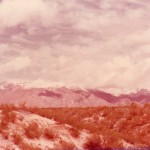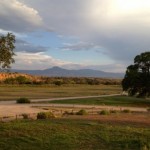Multimídia » Fotos » Faroeste americano
Faroeste americano
Esta foto é de Tucson, Arizona, no ano de 1979. É inverno, e os cumes das montanhas no horizonte estão cobertos de neve. Quem a tirou foi um americano que, depois de viver, estudar e trabalhar em Washington D.C., mudou-se para o Arizona em busca do horizonte que guiou os passos de seus ancestrais. Como disse Robert Frost em The Gift Outright:
“…Such as we were we gave ourselves outright
(The deed of gift was many deeds of war)
To the land vaguely realizing westward,
But still unstoried, artless, unenhanced,
Such as she was, such as she would become.”
…Assim como éramos nos demos sem reservas
(O ato de entrega foi muitos atos de guerra)
À terra vagamente se voltando para o oeste,
Mas ainda sem história, rude, sem brilho,
Assim como era, assim como se tornaria.
Na carta em que inseriu a foto, John Lockwood escreveu:
“I don’t see the future: only cactus, rocks, the sky.”
Nos Estados Unidos, é possível perceber o contraste entre o respeito ao indivíduo garantido pela Constituição e a diluição do indivíduo levada a cabo pela massificação crescente da sociedade. Posso estar enganada, mas a mudança de John Lockwood para o Arizona parece ter sido o desejo de escapar da sociedade de massa, a busca de uma identidade agreste ainda (?) resistente à avalanche dos vários meios de comunicação e informação que consegue enfraquecer e até apagar os contornos da individualidade.
Como sabemos todos pelos vários filmes de faroeste, a expansão dos Estados Unidos rumo ao Pacífico foi eivada de contradições, mas em meio aos tiroteios traçaram-se ali linhas mestras da vida americana. Num show de Bob Dylan, quando ele e os músicos executavam “Ballad of a Thin Man”, a iluminação projetou suas sombras na parede atrás do palco, e os contornos de seus corpos e chapéus em movimento criaram em negativo um antigo filme de faroeste, em que o refrão “Because something is happening here / But you don’t know what it is /Do you Mr. Jones?” introduzia perguntas.
Semelhante a muitos personagens de Guimarães Rosa que enveredam pelos Gerais em busca de identidades que apenas pressentem, imagino que John Lockwood buscava tesouro de grande valia no Arizona, e apraz-me visualizá-lo andando com seu pastor alemão pela paisagem inóspita que esta foto reproduz com grande beleza. A passagem do tempo alterou a química das cores, e os cumes nevados pairando sobre o campo desértico até parecem uma pintura.
Sandy Robertson é outra americana que decidiu seguir a vereda em direção ao Oceano Pacífico. Mora em San Diego e, como John Lockwood, faz questão de frisar que se acha apenas a alguns quilômetros do México. Os dois, fluentes em espanhol. A foto que enviou é de Ghost Ranch ao norte de Abiquiu, Novo México, região famosa pela presença da pintora americana Georgia O’Keefe, que ali fixou residência na década de 1940. Como a artista se expressou em 1943: “Um lugar tão belo, intocado, solitário, uma parte tão refinada do que chamo o “Longínquo”. É um lugar que já pintei antes… mesmo agora tenho que pintá-lo de novo.”
The American Far West
This photograph shows a landscape of Tucson, Arizona, in the year of 1979. It is winter, and the peaks of the mountains on the horizon are covered with snow. The man that took the photo was an American who after living, studying and working in Washington D. C. moved to Arizona in search of the horizon that guided the steps of his ancestors. As Robert Frost said in The Gift Outright:
“…Such as we were we gave ourselves outright
(The deed of gift was many deeds of war)
To the land vaguely realizing westward,
But still unstoried, artless, unenhanced,
Such as she was, such as she would become.”
In the letter that accompanied the photo, John Lockwood wrote:
“I don’t see the future: only cactus, rocks, the sky.”
In the United States it is possible to perceive the contrast between respect for the individual as guaranteed by the Constitution and the dilution of the individual caused by the increasing massification of society. I may be wrong, but John Lockwood’s migration to Arizona seems to have been the desire to escape from mass society, the search of a less urbanized identity still able to resist the avalanche of numerous means of communication and information that succeeds in weakening and even effacing the outlines of individuality.
As we all know through the various Western movies, the expansion of the United States toward the Pacific was fraught with contradictions, but in the midst of the gunfights and shoot-outs some major lines of American life were traced. During a Bob Dylan concert, when he and the musicians were performing “Ballad of a Thin Man”, the scenic lighting cast their shadows on the wall behind the stage, and the outlines of their moving bodies and hats created negatives of an old Western movie, into which the refrain “Something is happening here / But you don’t know what it is / Do you Mr. Jones?” introduced questions.
Just like many characters in the novels of Guimarães Rosa that make their way toward the Gerais in search of identities they can only surmise, I suppose that John Lockwood looked for a treasure of great value in Arizona, and I like to imagine him walking with his German Shepherd in that wild landscape reproduced in this photo with great beauty. Time has altered the chemistry of the colors, and the snowy peaks hovering above the barren field look even more like a painting.
Sandy Robertson is another American that decided to follow the track westward to the Pacific Ocean. She lives in San Diego and, like John Lockwood (both fluent in Spanish), insists on stressing she resides only a few miles from Mexico. She sent a photo taken at the Ghost Ranch, just north of Abiquiu, New Mexico, a place made famous by the presence of the American painter Georgia O’Keefe, who moved there from New York City in the 1940s. As the artist put it in 1943: “Such a beautiful, untouched lonely feeling place, such a fine part of what I call the ‘Faraway’. It is a place I have painted before . . . even now I must do it again.”


